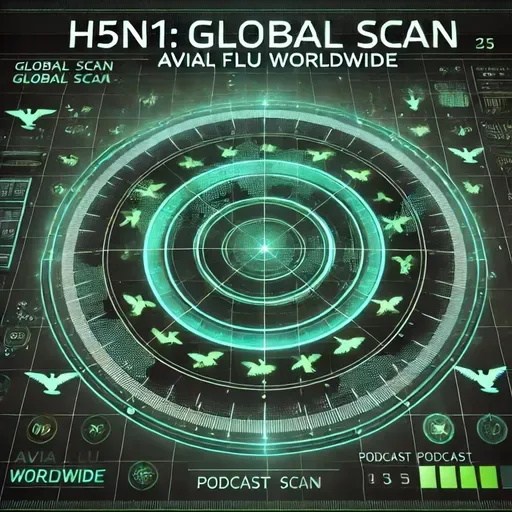
01 September 2025
H5N1 Avian Flu Spreads Globally: Urgent Update on Pandemic Threat to Poultry, Wildlife, and Human Health in 2025
H5N1 Global Scan: Avian Flu Worldwide
About
This is H5N1 Global Scan: Avian Flu Worldwide. I’m your host, guiding you through the urgent story of H5N1’s impact across our planet. Since 2020, the highly pathogenic H5N1 avian flu strain has swept almost every continent, decimating wild birds, poultry, and even some mammals. By mid-2025, the Centers for Disease Control and Prevention note that H5N1 remains widespread—causing animal outbreaks and sporadic human infections from North and South America to Asia, Africa, and Europe. Australia is one of the few to have avoided major outbreaks.
Let’s break it down continent by continent. In the Americas, the Pan American Health Organization highlights that over 100 outbreaks have hit commercial poultry in the United States so far this year, with additional detections in wild birds. Neighboring Mexico reported its first fatal human H5N1 case in April. South America, particularly Peru, continues to battle outbreaks among backyard birds. According to the FAO, animal outbreaks have also persisted in Europe and Asia, with over 300 global outbreaks reported since October 2024.
Asia remains a critical concern for human health. The World Health Organization reports that Cambodia has seen a sharp rise in H5N1 human cases this year, mostly children, with several fatalities linked to close contact with sick poultry. India too reported a fatal human infection in April. Across Africa and Europe, outbreaks have been linked to both migratory birds and livestock, disrupting food security and trade.
International research efforts are intensifying. Multidisciplinary teams in Europe, as published in Emerging Infectious Diseases and Ecological Evolution, have identified the virus's spread not only among birds but also in carnivorous mammals and raptors. U.S. and European labs are tracking the virus’s genetic changes, with the CDC explaining that the current H5N1 strains are distinct from previous years, complicating control measures.
Global coordination remains paramount. The World Health Organization and Food and Agriculture Organization have issued frequent joint statements, urging countries to report outbreaks swiftly and share data transparently. The WHO currently assesses the overall risk to the general population as low, but warns frontline workers face more significant hazards.
International trade faces significant headwinds. The culling of millions of birds led to egg and poultry shortages, especially in the U.S. and Europe, causing price shocks and export bans. Cross-border animal movement has led to disputes and stricter trade rules, impacting agriculture-dependent economies.
Global vaccine development is advancing, though unevenly. Existing poultry vaccines have shown mixed results as new virus variants emerge. International consortia are rushing to trial new human vaccines with broader protection. However, many countries—especially those in the Global South—struggle with access.
National approaches vary: The U.S. and Europe have deployed aggressive culling and surveillance, while Southeast Asian countries focus on backyard poultry management and community education. India and Cambodia rely on rapid detection, quarantine, and compensation for farmers. Each region’s strategy is shaped by infrastructure, resources, and culture, with both successes and setbacks.
Thanks for joining me on H5N1 Global Scan: Avian Flu Worldwide. For more global health insights, come back next week. This has been a Quiet Please production. To find out more about me, visit QuietPlease.ai.
For more http://www.quietplease.ai
Get the best deals https://amzn.to/3ODvOta
Let’s break it down continent by continent. In the Americas, the Pan American Health Organization highlights that over 100 outbreaks have hit commercial poultry in the United States so far this year, with additional detections in wild birds. Neighboring Mexico reported its first fatal human H5N1 case in April. South America, particularly Peru, continues to battle outbreaks among backyard birds. According to the FAO, animal outbreaks have also persisted in Europe and Asia, with over 300 global outbreaks reported since October 2024.
Asia remains a critical concern for human health. The World Health Organization reports that Cambodia has seen a sharp rise in H5N1 human cases this year, mostly children, with several fatalities linked to close contact with sick poultry. India too reported a fatal human infection in April. Across Africa and Europe, outbreaks have been linked to both migratory birds and livestock, disrupting food security and trade.
International research efforts are intensifying. Multidisciplinary teams in Europe, as published in Emerging Infectious Diseases and Ecological Evolution, have identified the virus's spread not only among birds but also in carnivorous mammals and raptors. U.S. and European labs are tracking the virus’s genetic changes, with the CDC explaining that the current H5N1 strains are distinct from previous years, complicating control measures.
Global coordination remains paramount. The World Health Organization and Food and Agriculture Organization have issued frequent joint statements, urging countries to report outbreaks swiftly and share data transparently. The WHO currently assesses the overall risk to the general population as low, but warns frontline workers face more significant hazards.
International trade faces significant headwinds. The culling of millions of birds led to egg and poultry shortages, especially in the U.S. and Europe, causing price shocks and export bans. Cross-border animal movement has led to disputes and stricter trade rules, impacting agriculture-dependent economies.
Global vaccine development is advancing, though unevenly. Existing poultry vaccines have shown mixed results as new virus variants emerge. International consortia are rushing to trial new human vaccines with broader protection. However, many countries—especially those in the Global South—struggle with access.
National approaches vary: The U.S. and Europe have deployed aggressive culling and surveillance, while Southeast Asian countries focus on backyard poultry management and community education. India and Cambodia rely on rapid detection, quarantine, and compensation for farmers. Each region’s strategy is shaped by infrastructure, resources, and culture, with both successes and setbacks.
Thanks for joining me on H5N1 Global Scan: Avian Flu Worldwide. For more global health insights, come back next week. This has been a Quiet Please production. To find out more about me, visit QuietPlease.ai.
For more http://www.quietplease.ai
Get the best deals https://amzn.to/3ODvOta